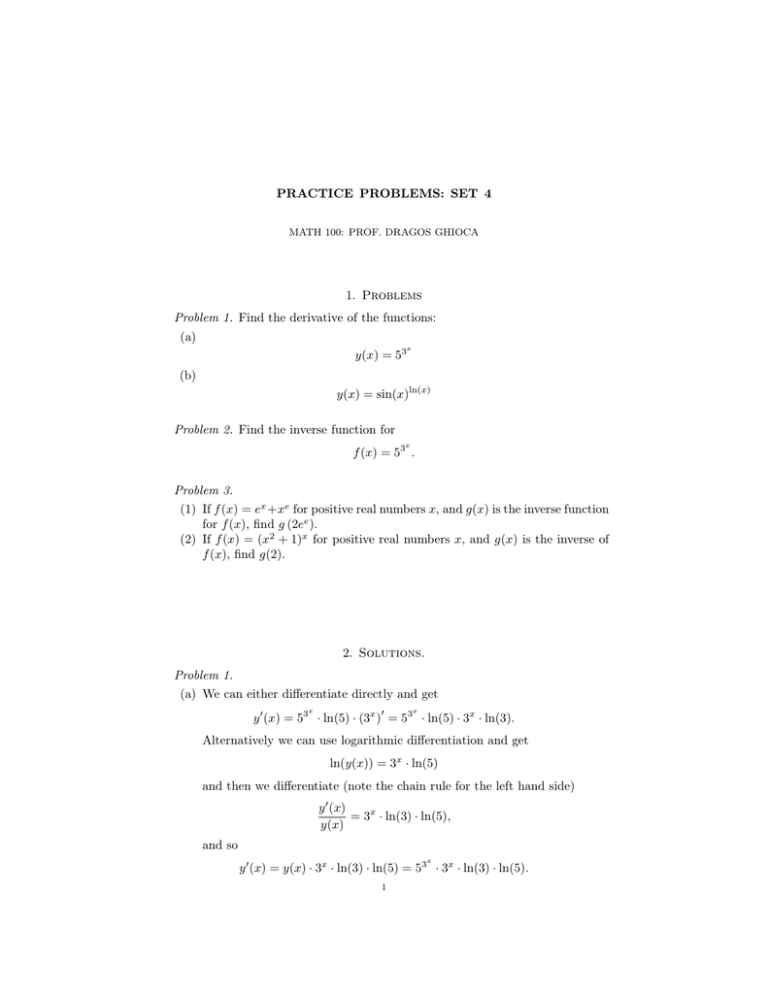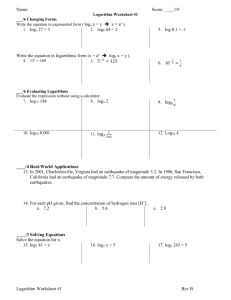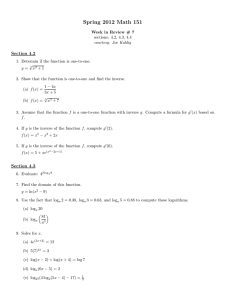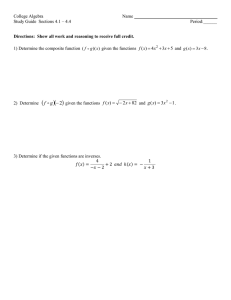PRACTICE PROBLEMS: SET 4 1. Problems (a) (b)
advertisement

PRACTICE PROBLEMS: SET 4 MATH 100: PROF. DRAGOS GHIOCA 1. Problems Problem 1. Find the derivative of the functions: (a) x y(x) = 53 (b) y(x) = sin(x)ln(x) Problem 2. Find the inverse function for x f (x) = 53 . Problem 3. (1) If f (x) = ex +xe for positive real numbers x, and g(x) is the inverse function for f (x), find g (2ee ). (2) If f (x) = (x2 + 1)x for positive real numbers x, and g(x) is the inverse of f (x), find g(2). 2. Solutions. Problem 1. (a) We can either differentiate directly and get ′ y ′ (x) = 53 · ln(5) · (3x ) = 53 · ln(5) · 3x · ln(3). x x Alternatively we can use logarithmic differentiation and get ln(y(x)) = 3x · ln(5) and then we differentiate (note the chain rule for the left hand side) y ′ (x) = 3x · ln(3) · ln(5), y(x) and so y ′ (x) = y(x) · 3x · ln(3) · ln(5) = 53 · 3x · ln(3) · ln(5). x 1 2 MATH 100: PROF. DRAGOS GHIOCA (b) We use logarithmic differentiation: ln(y(x)) = ln(x) · ln(sin(x)), and then differentiate 1 cos(x) y ′ (x) = · ln(sin(x)) + ln(x) · , y(x) x sin(x) and so y ′ (x) = sin(x)ln(x) · ( ln(sin(x)) ln(x) · cos(x) + x sin(x) ) . Problem 2. We let y = g(x) be the inverse function of f (x). Then f (g(x)) = x, y or in other words, f (y) = x. But f (y) = 53 ; so y 53 = x. We apply the logarithm in base 5 to both sides and compute 3y = log5 (x). Then we apply the logarithm in base 3 and get y = g(x) = log3 (log5 (x)) is the inverse function for f (x). Second solution: In order to find y = g(x) the inverse function of f (x), we could work only with the natural logarithm ln. So, from f (g(x)) = x which yields f (y) = x and thus y 53 = x. We apply the natural logarithm and get 3y · ln(5) = ln(x), and so, ln(x) . ln(5) Then applying again the natural logarithm yields ( ) ln(x) y · ln(3) = ln , ln(5) 3y = and thus the inverse function is ( ln y = g(x) = ln(x) ln(5) ln(3) ) . The two expressions for g(x) computed with the above two methods are the same since ln(x) . log5 (x) = ln(5) Similarly, for any t we have ln(t) . log3 (t) = ln(3) PRACTICE PROBLEMS: SET 4 3 The above properties of the logarithm are just as important as the identities: loga (A · B) = loga (A) + loga (B) and loga (AB ) = B · loga (A), for any positive real numbers a, A and B. Problem 3. For these type of questions, we want to guess the value b = g(a) such that f (b) = f (g(a)) = a. because g(x) is the inverse of f (x). We only guess the value b = g(a) since it is very hard to find the actual formula for g(x), the inverse function of f (x). But guessing the value b = g(a) turns out not to be very difficult. (a) So, we have f (x) = ex + xe and we want to find g (2ee ). So, we want to guess the value b = g (2ee ) such that f (g (2ee )) = 2ee , i.e. f (b) = 2ee . In other words, b satisfies eb + be = 2ee . It’s not hard to guess that b = e works. So, g (2ee ) = e. (b) This time we have f (x) = (1 + x2 )x and we want to find g(2). So, letting b = g(2) then f (g(2)) = 2 and so, f (b) = 2. In other words, b satisfies (1 + b2 )b = 2. It’s not hard to guess that b = 1 works. So, g(2) = 1.








